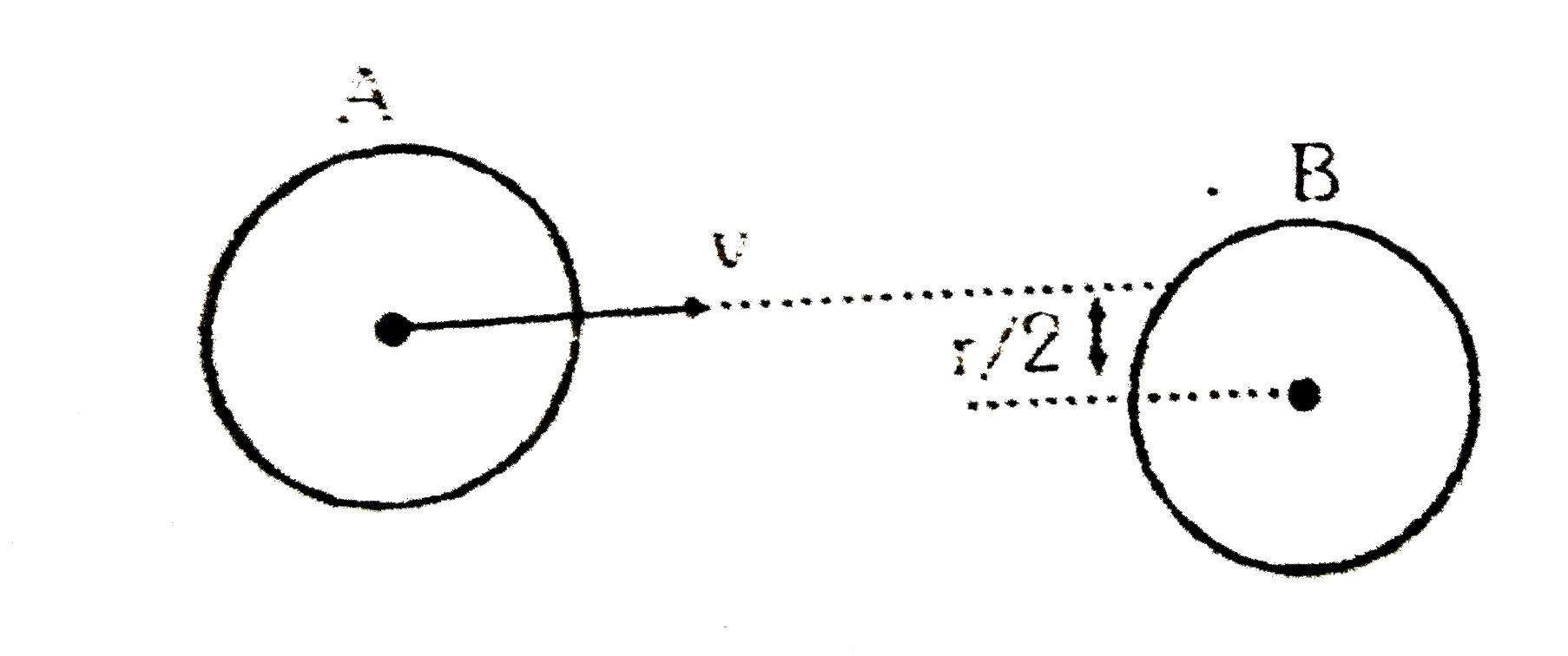The blocks shown in figure have equal masses. The surface of A is smooth but that of B has a friction coefficient of 0.10 with the floor. Block A is moving at a speed of 10 m/s towards B which is kept at rest. Find the distance travelled by B if a. the collision is perfectly elastic and b. the collision is perfectly inelastic. Take g=10ms2.
 Solution in Tamil
Solution in Tamil
V1=10ms
V2=0
v1,v2→ velcity of A and B after collision a. if the collision is perfectly elastic
mV1+mV2=Mv1+mv2
→10+0=v1+v2
v1+v2=10…..i
Again v1+v2=−(u1−v2)
=−(10.0)=−10…ii
Substracting ii frm ii
2v2=20
→v2=10ms
the deceleration of B
pu∈gworke≠rgypr∈cip≤<br>:.(1/2)xxmxx(0)^2-91/2)xxmxxv^2<br>=-mxxaxxh<br>rarr -(1/2)xx (10)^2=-mugxxh
→h=1002×1×10=50m
b. if the collision is perfectly in elastic
m×u1+m×u2=(m+m)×v
→m×10+m×0=2m×v
→v=(102)=5ms
The two blocks will move together sticking to each other
∴Pu∈gworke≠rgypr∈cip≤<br>(1/2)xx2mxx(0)^2xx2mxx(v)^2<br>=2mxxmugxxs<br>rarr ((5)^2)/(0.1xx10xx2)=S<br>=S=12.5m
Topper's Solved these Questions
Similar Questions
The centre of mass of a system of particles is at the origin. It follows that:
11:26View SolutionAn aluminium vessel of mass 0.5kg contains 0.2kg of water at 20∘C A block of iron of mass 0.2kgat100∘C is gently put into the water .Find the equilibrium temperature of the mixture, Specific heat capacities of aluminium , iron and water are 910Jkg−1K−1470Jkg−1K−1and4200Jkg−1K−1 respectively
12:41View SolutionFind the accelerationof the moon with respect to the eath from the following data, Distance between the earth and the moon =3.85×105 km and the time taken by the moon to complete one revolution around the earth =27.3days
05:08View SolutionThe friction coefficient between the horizontal surface and each of the blocks shown in figure is 0.20. The collision between the blocks is perfectly elastic. Find the separation between the two blocks when they come to rest. Take g=10ms2.
 03:06View Solution
03:06View SolutionThe friction coefficient between the horizontal surface and each of the block shown in the figure is 0.2 . The collision between the blocks is perfectly elastic. Find the separation between them when they come to rest. (Take g=10m//s^2 ).
10:58View SolutionA sphere of mass m slides with velocity v on as frictionless surface towards a smooth inclined wall as shown in figure. If the collision with the wall is perfectly elastic find a. the impulse imparted by the wall on the sphere b the impulse imparted by the floor on the sphere.
04:00View SolutionFor a perfectly elastic collision and a perfectly inelastic collision, values of coefficient of restitution are respectively
07:24View SolutionA disk A of radious r moving on perfectly smooth surface at a speed v undergoes an elastic collision with an identical stationary disk B. Find the velocity of the disk B after collision if the impact parameter is r/2 as shown in the figure :-
 08:11View Solution
08:11View Solutionचित्र में दर्शाए गए दोनों ब्लॉकों का द्रव्यमान समान है। A की सतह चिकनी है, किंतु B की सतह का क्षैतिज सतह के साथ घर्षण गुणांक 0.10 है। प्रारंभ में B स्थिर है तथा A इसकी ओर 10 m/s चाल से चल रहा है। टवकर के बाद रुकने के पहले B के द्वारा तय की गई दूरी निकालें यदि
(a) टक्कर पूर्णतया प्रत्यास्थ है।
 04:12View Solution
04:12View Solutionचित्र में दर्शाए गए दोनों ब्लॉकों का द्रव्यमान समान है। A की सतह चिकनी है, किंतु B की सतह का क्षैतिज सतह के साथ घर्षण गुणांक 0.10 है। प्रारंभ में B स्थिर है तथा A इसकी ओर 10 m/s चाल से चल रहा है। टवकर के बाद रुकने के पहले B के द्वारा तय की गई दूरी निकालें यदि
टक्कर पूर्णतया अप्रत्यास्थ है। g=10m/s2 ले
 04:54View Solution
04:54View SolutionIn the arrangement as shown, block A of mass 3 kg moves towards left with velocity 10m//s . Initially block A is 100m from pulley on a smooth surface. Block B is of mass 2kg ( g = 10 m//s^(2) )
05:03View SolutionThree blocks of masses m , m and M are kept on a frictionless floor as shown in the figure .The leftmost block is given velocity v towards the right . All the collision between the blocks are perfectly inelastic . The loss in kinetic energy after all the collision is 5//6th of initial kinetic energy. The ratio of M//m will be
08:23View SolutionTwo steel balls A and B of mass 10 kg and 10 g rolls towards each other with 5 m/s and 1 m/s respectively on a smooth floor. After collision, with what speed B moves (perfectly elastic collision)?
13:11View SolutionTwo steel balls A and B of mass 10 kg and 10 g rolls towards each other with 5m/s and 1 m/s respectively on a smooth floor. After collision, with what speed B moves [perfectly elastic collision]?
03:08View SolutionThe friction coefficient between the horizontal surfce and ech of the blocks shown in figure is 0.20. The collision between the blocks is perfectly elastic. Find the separation between the two blocks when they come to rest. Take g=10ms2.
 03:08View Solution
03:08View SolutionThe friction coefficient between the horizontal surface and each of the block shown in the figure is 0.2 . The collision between the blocks is perfectly elastic. Find the separation between them when they come to rest. (Take g=10m//s^2 ).
View Solution
